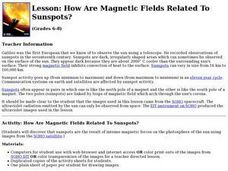Curated OER
Do Fast CMEs Produce Intense SPEs?
In this coronal mass ejections and Solar Proton Events worksheet, students create a Venn Diagram to represent given data. They answer 5 questions about the data related to the number of coronal mass ejections and Solar Proton Events...
Curated OER
An application of the Parallax Effect
In this parallax effect activity, learners observe 2 photographs taken of an active area of the sun by 2 STEREO satellites and 1 photograph taken of the same active area of the sun by the SOHO satellite. Students observe the shift in...
Curated OER
CME Kinetic Energy and Mass
In this kinetic energy and mass worksheet, high schoolers read about coronal mass ejections detected by the SOHO satellite. Students complete a data table that shows the relationship between kinetic energy, speed and mass. They convert...
Curated OER
Changing Perspectives on the Sun's Diameter
In this sun's diameter worksheet, students use a photograph taken by the SOHO satellite of the sun showing a change in diameter from one month to another. Students find the average diameter of the sun, they determine the percent change...
Curated OER
Cosmic Rays and Solar Cells
In this cosmic rays and solar cells worksheet, students read about how cosmic rays damage the electrical output of solar cells over time on satellites. Students use a graph of the solar power output compared to the year for the SOHO...
Curated OER
The Hinode Satellite Views the Sun
In this sun's magnetic field lines worksheet, students use a photograph taken by the Hinode Satellite that shows the complex magnetic structure of the sun over a sunspot. Student predict the magnetic field lines and draw them on a...
Curated OER
How Far Away is SOHO?
Students create a scale model of the Earth and the sun that demonstrates where the SOHO satellite is in relation to the Earth.
Curated OER
A Look At Sunspots
Students research how the development of new technology has increased our knowledge of how the sun works. This lesson is part of a three-part series aimed at showing students how our knowledge of the universe must be inferred through the...
Curated OER
Sunspots 3: Tracking the Movement of Sunspots
Students analyze sunspots through the use of solar imaging from satellite instruments. They collect two types of images, and track the movement of sunspots using a latitude/longitude grid.
Curated OER
Solar Storms-Fractions and Percentages
In this solar storms worksheet, students find the percentage of X-Flares and Halo CMEs that occurred in solar storms and complete a Venn Diagram comparing the numbers of each.
Curated OER
Tracking the Movement of Sunspots
Pupils examine how the development of new technology has increased our knowledge of how the sun works. Students study sunspots through the use of solar imaging from satellite instruments.
NASA
Space-Based Astronomy on the Internet
Young scientists compile everything they have learned into a report in the fifth and final lesson in a unit on the visible light spectrum. Access to photos from observatories, telescopes, and satellites allows learners to compare and...
Curated OER
How Are Magnetic Fields Related To Sunspots?
Young scholars discover that sunspots are the result of intense magnetic forces on the photosphere of the sun by observing images from the SOHO satellite.
Curated OER
How Can a Spacecraft Always Face the Sun?
Students determine the correct orbital path for a satellite that collects data about the sun so that its view of the sun never be obstructed by the Earth.
Curated OER
Sunspots: Correlating Sunspots to Active Regions
Students investigate sunspots. They use solar imaging from satellite instruments which are currently circling the sun. Students compare images from the satellites and determine the existence of a correlation between the two types of...
Curated OER
Solar Flip Book
Students view and discuss various images of solar events. They research and create a flip book demonstrating the progression of two solar events, and write a poem describing their chosen solar event.
Curated OER
Solar Storm Timeline
In this solar storm timeline, students read about a series of events that took place in space beginning with a solar flare. Students gather the information and create a time line of events mentioned. They determine the length of time it...
Curated OER
Data Corruption by High-Energy Particles
In this data corruption by high-energy particles, students solve 4 problems about the solar flare that corrupted the imagers measuring them. Students find the speed of the arriving particles and the percentage of light-speed the...
Curated OER
A Bird's Eye Look at the Sun-Earth System
In this Sun-Earth system activity, students fill in blanks with the proper terms from a given list to complete a summary of the relationship between the Sun and the Earth. A major topic includes how solar storms effect the Earth and the...
Curated OER
Measuring Speed in the Universe
In this measuring speed in the universe instructional activity, students use photographs of 3 astronomical phenomena including supernova explosions, coronal mass ejections and solar flare shock waves to find how fast they move. The...
Curated OER
Solar Storms: Sequences and Probabilities
For this sequences and probabilities worksheet, students read about solar storms and determine the probability that none of the events occurred on the same day.






















